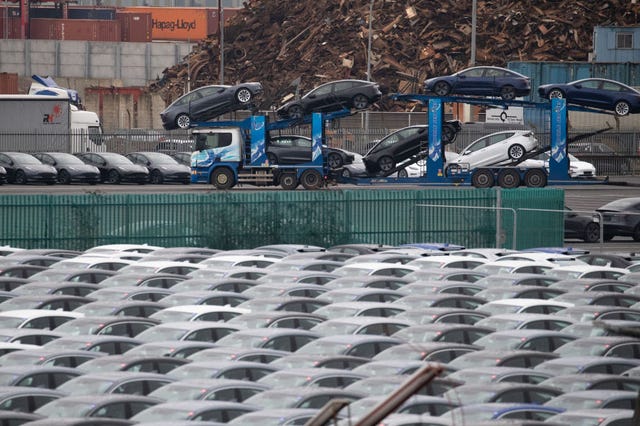
Andrew Matthews - PA ImagesGetty Images
- A new report from BloombergNEF (BNEF) estimates that, even with no new economic or policy initiatives put forth by global governments, EVs and other zero-emissions vehicles will account for 70 percent of new-vehicle sales by 2040, up from 4 percent in 2020.
- But to meet the goal of having net-zero emissions by 2050, a goal stated in the current policies of countries including Canada, the European Union, the United Kingdom, and the United States, BNEF estimates there will need to be policy measures to encourage further adoption of EV and other zero-emissions vehicles, especially in the heavy-duty truck fleet.
- Some policies encouraging EV adoption are already in place, but more will need to be adopted to meet the most aggressive emissions goals.
For all the news from carmakers about new and future electric vehicles, you'd think EVs already made up a big part of the global vehicle fleet. But you'd be wrong. Though sales of EV passenger cars are on the upswing—especially in Europe and China—EVs still only account for a small percentage of new-car sales and an even smaller share of cars on the road. A new report from research firm BloombergNEF (BNEF) projects that things could look quite different by 2040, when BNEF says 70 percent of passenger cars could be EVs or other zero-emission vehicles such as fuel-cell vehicles. But even that huge growth won't be enough for the governments that say they're targeting net-zero carbon emissions by 2050.
BNEF's report tallies three million global passenger-car EV sales in 2020. The report predicts that those sales will rise to 14 million by 2025 and will account for almost 70 percent of new-car sales globally and 90 percent of new-car sales in Europe by 2040, even without new investment or enticement from global governments. But some governments, including Canada, the European Union, and the United States, have announced ambitious plans to produce net-zero carbon emissions by 2050. And even given BNEF's rosy estimates, there would still be internal-combustion-engine (ICE) cars on the roads gobbling up fossil fuels and spewing out carbon emissions by that date.
How to Electrify the Commercial-Truck Fleet?
To avoid a smoggy future, BNEF says governments will need to nudge the hand of the market by subsidizing EV infrastructure, setting stricter limits on carbon dioxide emissions, and implementing mandates for the electrification of commercial truck fleets, which have so far been much slower to electrify than the passenger-car segment. The report also suggests limiting vehicle traffic in urban centers.
Electrifying the commercial truck fleet by 2050 may be the most challenging of the proposals BNEF's report prescribes. Daimler, Tesla, and Volvo are among the companies working on delivering Class 8 heavy duty trucks, but Volvo's effort is so far only good for last-mile deliveries, not the long-haul routes that prop up the American supply chain, and one of the leaders of Tesla's semi project left the company this week. The Tesla Semi project has been delayed several times.
Many of the other strategies the report proposes are already in place in some parts of the world. Europe and China have set relatively strict emissions standards. Cities seized on lower vehicle traffic during the early days of the coronavirus pandemic to limit cars' access to city centers, and some are sticking to their guns even as people begin to return to more normal routines. President Biden is in the midst of a so far unproductive round of negotiations with Congress over his proposed infrastructure bill, which would provide funding for an expansion of the U.S.'s EV charging network. BNEF says that growing the global charging network will be key to the high levels of adoption the report is predicting.
Of course, there's no way to know now whether BNEF's predictions will bear out. The study predicts high levels of EV adoption 20 years from now. But just over 20 years ago, fears about the Y2K bug were a matter of grave international concern, and none of the massive global changes that have occurred since the start of the coronavirus pandemic could have been predicted even at the end of 2019. The level of EV adoption over the next two decades is likely to turn on factors we can't yet conceive of. One thing we do know (almost) for sure: whether people decide to buy EVs or not, there will soon be plenty of them to choose from.
This content is imported from {embed-name}. You may be able to find the same content in another format, or you may be able to find more information, at their web site.
This content is created and maintained by a third party, and imported onto this page to help users provide their email addresses. You may be able to find more information about this and similar content at piano.io
"car" - Google News
June 10, 2021 at 06:01AM
https://ift.tt/3iyM93A
Here’s What it Will Take for EVs to Take Over the Car Market - Car and Driver
"car" - Google News
https://ift.tt/2SUDZWE
https://ift.tt/3aT1Mvb
Bagikan Berita Ini














0 Response to "Here’s What it Will Take for EVs to Take Over the Car Market - Car and Driver"
Post a Comment